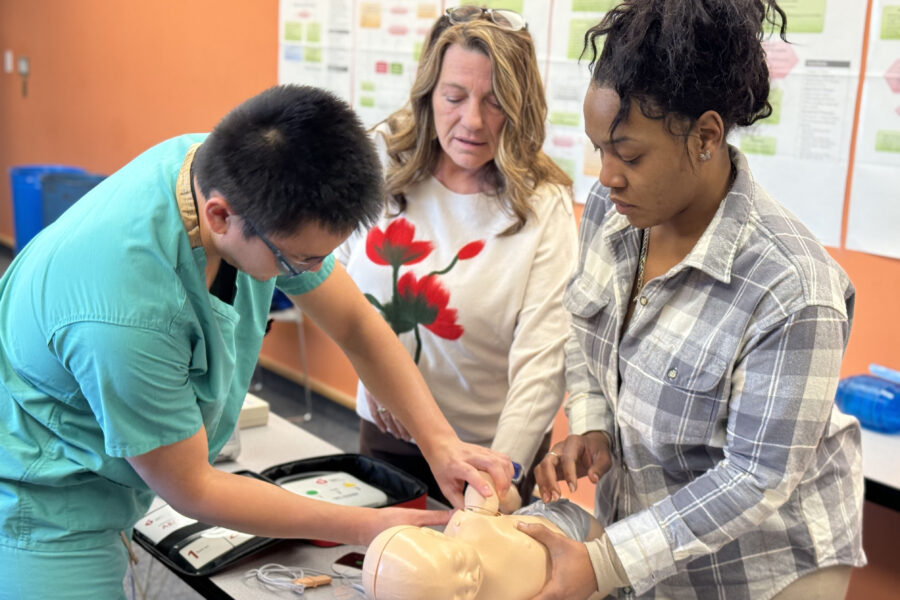In 1989, Debra Von Seggern didn’t know CPR when her 8-month-old son stopped breathing because of an airway obstruction.
“We were in another state. It was during an ice storm. The closest hospital didn’t have an ambulance,” Von Seggern remembered.
Although she lacked CPR knowledge, Von Seggern and her husband were able to clear the obstruction and get her son breathing again.
“It was basic life support that saved him.”
The incident left Von Seggern with an appreciation for CPR. She took a class to learn it. Then another to learn more.
“That’s what threw me into this, and why I have a big heart for teaching CPR in schools, to kids and to new moms.
“When we moved back to Nebraska, someone asked me to join a volunteer fire department,” Von Seggern said. She remains a volunteer with the North Bend Fire Department.
And she joined UNMC’s Center for Continuing Education.
That was in 2002. At the time, Von Seggern was an emergency medical services American Heart Association instructor, and the CCE’s AHA Training Center program taught only advanced cardiovascular life support and pediatric advanced life support courses. The courses were taught on site, and the program served about 300 students annually.
Lisa Bally, director of finance and operation for the CCE, remembers Von Seggern’s arrival.
“When Deb joined CCE, the EMS program was barely active, and there was a strong need to establish it as the premiere educational venue in the state of Nebraska,” Bally said. “Deb and I had many conversations back then about continuing to do the right things and doing them better than anyone else. We knew that in the long run, the CCE EMS program would save lives. Deb hung in there and continued to push for what the program needed.”
Today, the program has grown to more than 225 instructors serving more than 12,000 students annually, including over 10,000 at sites in rural Nebraska and six other states.
“Our EMS efforts, which are largely occurring under the radar, are one of the most far-ranging and impactful services UNMC provides to the citizens of Nebraska,” said Jeffrey Harrison, MD, chair of the UNMC Department of Family Medicine and medical director of the AHA program. “If you look at the quality of our courses and the high standard we set for our instructors and learners, this truly is a difference maker for the public good.”
Von Seggern and her team – Bridget Bauman and Sonya Ross – have been a big part of making that difference.
“I added BLS (basic life support) manikins with my own money to get the BLS program going,” Von Seggern said. “Some of them still are being used, which is cool.”
The AHA program was able to grow its educational reach in partnership with rural school systems, daycares, small hospitals, clinics and the many volunteer EMS services, Von Seggern said. CCE experts spoke at conferences, worked with schools to fund classes, created the Heart Safe School program and involved local fire departments. The support of the Nebraska EMS Association was huge, she said.
“The Heart Safe School program,” Bally said, “is another example of thinking outside the box to find ways to spread this invaluable knowledge to everyone, not just health professionals and is a shining example of the bottom line of the CCE EMS program – to save more lives.”
A recent note from a teacher at one of the Heart Safe School rural Nebraska sites – where students, faculty and staff are taught CPR and other AHA interventions – sums up the program’s success.
“We have been teaching students BLS CPR in 7th and 9th grade. Everyone goes through the class for a participation grade; however, we give them the option that if they would like to be certified they sit for the exam and pay for the card.
“For our staff, we had a goal of having at least 25% of our teachers and staff be CPR certified, but our numbers have grown significantly. We currently have 75% of our staff and teachers CPR certified.
“We have a team of 12 staff/teachers that make up our Cardiac Emergency Response Team that will mobilize anytime a Code AED goes out over the loudspeaker and over the radios. It is our goal to recognize a cardiac emergency, start CPR and defibrillate prior to two minutes, even though the gold standard is three minutes. We have AEDs on every floor of the school and the team is made up of members that are spread throughout the whole school so a member is close and can start immediately.”
“When I came to UNMC, we said, ‘We have to get into the schools,” Von Seggern said. “A response like this shows that all the effort continues to pay off – and lives will continue to be changed.”
